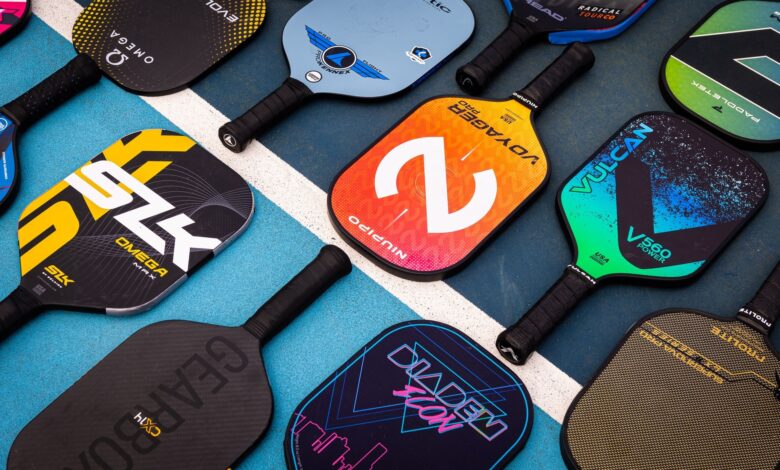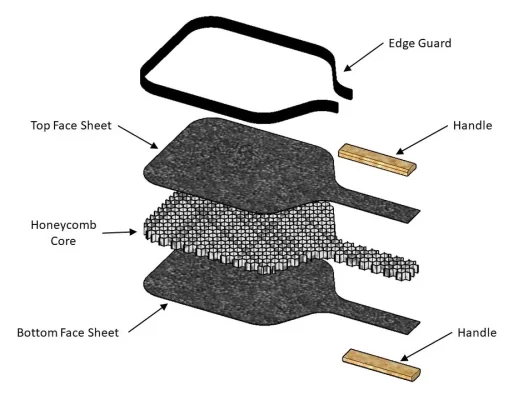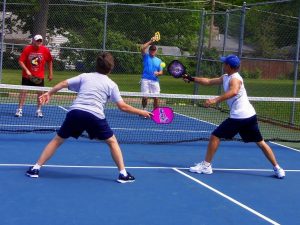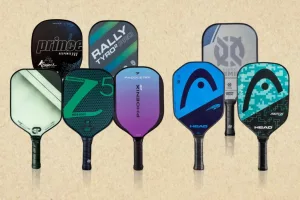Choosing the Best Pickleball Paddle: A Comprehensive Guide

Table of Contents
How to Choose the Best Pickleball Paddle
I. Introduction
Welcome to the ultimate guide on finding the best pickleball paddle for you. Whether you’re a seasoned player or just starting in the world of pickleball, choosing the right paddle is crucial for your performance on the court. In this guide, we’ll delve into the key factors that make a paddle suitable for different playing styles and skill levels, providing you with the knowledge you need to make an informed decision and start dominating the court. If you’ve never played before check out our blog on How To Learn & Get Started In Pickleball
II. Understanding Pickleball Paddles
Before diving into the selection process, let’s take a look at the components that make up a pickleball paddle. Understanding the materials and design elements will empower you to make a choice that aligns with your preferences and playing style.

A. Pickleball Paddle Materials
- Paddle Face Material: The most common types of paddle face materials are wood (rather outdated at this point), fiberglass, graphite, and carbon fiber. There are also a few companies offering hybrid blends. Carbon fiber has become the most popular among the pros in the last few years for it’s control and spin capabilities. However, graphite and fiberglass are far from obsolete and usually come at a better price point. If you want to go deeper into which material is best for you, click here.
- Core Material: Polymer (aka polypropylene, poly core, or simply “poly”) and Nomex are the two most popular cores. Nomex has been around longer. It is lightweight, has a ton of pop, and is fairly loud. Polymer is similar in weight, a little more controlled but less powerful, and significantly quieter than Nomex. Keep in mind that each manufacturer’s core design varies slightly both in density and thickness, so even with the same core material, the results will vary. You may also come across paddles with an aluminum core, though they are a little more rare. Aluminum is the lightest material, but offers very little power.
B. Other Pickleball Paddle Components
- Thickness: Most models of pickleball paddles come in two thicknesses: 14mm and 16mm. The thicker the paddle, the more give in the core. This leads to more control and spin with less pop and vice versa. Choose the paddle that is right for you based on your strengths. You can check out our full thickness guide here.
- Handle Length: Finding the handle length that fits you is one of the biggest factors in finding your paddle. USA Pickleball guidelines state that a paddle length plus width may not exceed 24 inches. Paddles are measured from the bottom of the butt cap to the top of the edge guard. Because of this, longer paddles often have slightly narrower hitting surfaces. Hand size, play style, and level of play all factor in to what fits you. If you come from a tennis background and like to use a two-handed backhand, the longer handle may be the one for you.
- Weight & Balance: The overall weight of your paddle should reflect your body type and size. Experiment with a friends paddle to find what feels natural. Weight distribution is a simple aspect of a paddle, but also makes a large difference. End-loaded paddles deliver more power while handle-heavy paddles give you more control and quickness on the kitchen line. Many players use lead tape to balance their favorite paddles.
- Shape: Most pickleball paddles are in a basic rectangular shape with rounded corners. This is a proven and effective design. Other styles are rounded on top in an effort to make the paddle more aerodynamic allowing for less drag on a swing. Another shape you will see is oval. The main appeal of the oval shape is that it tends to be easier on the elbow and has a larger sweet spot.
III. Identifying Your Playing Style and Skill Level
To find your perfect pickleball paddle, you first need to assess your playing style and skill level accurately. This section will help you identify your strengths and weaknesses on the court.

A. Different Playing Styles in Pickleball
- Aggressive: You fall into this category if you are quick to attack and prefer to play with tempo. You may prefer to drive the third shot in favor of a third shot drop. Aggressive players look for ways to speed up play rather than lock into long dink battles.
- Finesse: Finesse players are, unsurprisingly, the inverse of the aggressive style. They tend to favor control and spin over power and tempo. Patience and precision allow a finesse player to wait out an opponent, refusing to make the first mistake.
- Balanced: Balanced players are somewhere in-between the other two styles. Look for a balanced paddle if you don’t like to sell out to either extreme.
B. Assessing Your Skill Level
- Beginner: New to the game? Check out our list of the best beginner paddles to find an easy, forgiving paddle you won’t have to break the bank to pick up. There is no reason to spend on a professional paddle before you know what fits your style.
- Intermediate: You’ve been in the game for a little while now and are ready to take a step up. Explore paddles designed for players with some experience, offering a balance of control and power.
- Advanced: You understand the game well. Little if any of the information in this post is new to you. Check out our favorite pro paddles here.
IV. Choosing the Right Paddle for You
Armed with insights into your playing style and skill level, let’s explore how to match these factors with specific pickleball paddles.

A. Paddle Specifications for Different Playing Styles
- Power-Oriented Paddles: Ideal for players seeking a strong and aggressive game. Find our top-rated power paddles here (coming soon).
- Control-Oriented Paddles: Suited for those who prioritize accuracy and finesse. Browse our Best Pickleball Paddles for Control (coming soon).
- Balanced Paddles: Find paddles that strike a balance between power and control. Check out our Top 7 Balanced Pickleball Paddles (coming soon).
V. Top 3 Pickleball Paddles to Consider
We listed 3 popular paddles to aid your search. Each one is a trusted brand with overwhelmingly positive reviews. You can’t really go wrong with any of them if you are just getting started.
1. Best Overall for Beginner/Intermediate: SLK Evo by Selkirk
Selkirk SLK Evo  |
Key Features:
- Comes in XL or Max sizes
- Multiple variations to match your playing style
Pros:
- You can find the perfect variation of the Evo for any play style
- Selkirk is one of the most trusted and consistent brands on the market
- Great for beginners or intermediate players
- Lightweight
Cons:
- Not ideal for 3.5+ rated players
User Testimonials:
- “Feels more advanced than just a basic pickle ball paddle.”
- “Forgiving on off center hits.”
2. Best Budget Starter Kit: Niupipo
Niupipo Pickleball Paddles  |
Key Features:
- Niupipo makes the best starter sets for those who want to try the sport without breaking the bank
Pros:
- Many different styles and colors
- Extremely Affordable
- Comes with everything you need to get started
Cons:
- Not for Intermediate and up
- Casual play only
User Testimonials:
- “Great paddle for the price! Very good value.”
3. Best Intermediate/Advanced: JOOLA Ben Johns Hyperion CAS
JOOLA Ben Johns Hyperion CAS  |
Key Features:
- Signature Paddle of the #1 ranked pickleball player, Ben Johns
- Newer Version Available, but for twice the price
Pros:
- High performing without the high price
- Great combination of control and power
Cons:
- Not recommended for beginners
User Testimonials:
- “Great spin, control and power.”
VI. Maintenance and Care Tips
Owning a quality pickleball paddle comes with the responsibility of proper maintenance. Follow these tips to ensure the longevity and optimal performance of your paddle.
A. Cleaning Your Pickleball Paddle
- Use a damp cloth to wipe down the paddle after each game.
- Remove any dirt or debris from the face and edges.
- Periodically clean the grip to maintain a secure hold.
- Avoid allowing the face to contact any hard or abrasive surfaces.
B. Storing Your Paddle Properly
- Store your paddle in a protective cover to prevent damage.
- Avoid extreme temperatures and direct sunlight.
- Keep the paddle in a dry place to prevent moisture-related issues.
C. Recognizing Signs of Wear and Tear
- Inspect your paddle regularly for cracks or dents.
- Note that the surface may lose grip over time, causing less ability to apply spin to the ball.
- Check the grip for wear and replace it if needed.
- Paddle cores are known to start to break down over time, especially if misused. You may not be able to tell by the outside appearance but will notice declining performance.
VII. Frequently Asked Questions
A. Common Questions About Pickleball Paddles
- How do I determine the right grip size?
- The main factor to consider when choosing the best grip size is the size of your hands.
- What weight range is suitable for my playing style?
- Midweight pickleball paddles weight between 7.3 to 8.3 ounces. Beginners should start somewhere in that range. Smaller players should stick to the lighter side while taller players may want to stay on the heavier side. As you gain more experience in the sport, you can fine tune your paddle weight to your preference.
VIII. Conclusion
In conclusion, finding the best pickleball paddle involves a thoughtful consideration of your playing style, skill level, and some personal preference. Don’t just buy based on the latest trend. Price does not always correlate with performance. Find the paddle that is best for you.
IX. Additional Resources
Enhance your pickleball journey with these additional resources:
- Coming Soon: (Top Paddles for 2024).
- Check out our blog for more info on what to look for in a paddle and our latest top recommendations.
